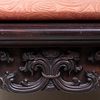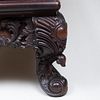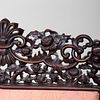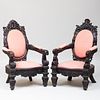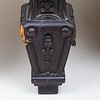Chinese Export Carved Hardwood and Upholstered Parlor Set
Bid Increments
| Price | Bid Increment |
|---|---|
| $0 | $25 |
| $200 | $50 |
| $500 | $100 |
| $3,000 | $250 |
| $5,000 | $500 |
| $10,000 | $1,000 |
| $30,000 | $2,500 |
| $100,000 | $5,000 |
Comprising:
A pair of armchairs, 45 3/4 x 28 1/2 x 31 in., height of seat 14 1/2 in.
A settee, 36 x 6 ft. 5 in. x 28 in.
For a similar example see Doyle New York, May 4, 2021, Lot 110.
Note: This suite was donated to the Historical Society of Newburgh by Bessie Aspinwall Wagner, daughter of the family who originally commissioned it. It is through the letters and notes of Bessie Aspinwall Wagner the history of the suite has been recorded.
This furniture was commissioned by the Aspinwall family through an English dealer to be made in China circa 1880 and reportedly imported on one of the family’s merchant ships. The Aspinwalls who used this parlor set had been living in New Jersey at that time and, at the turn of the 20th century, John Aspinwall built a home in Newburgh, NY when he established his factory there, producing the innovative Fabrikoid which was an artificial leather. Fabrikoid was ‘capable of giving an imitation of all kinds of leather in all colors and patterns’. Beginning as an alternative upholstery material for carriages, Fabrikoid was quickly promoted for use in suitcases, baseball coverings, shoe and hat linings, hospital sheeting and more. As automobiles took center stage in transportation, Mr. Aspinwall's company was positioned to offer upholstery and car tops perfect for weather exposure. By 1906, the company boasted that each month they made enough artificial leather to reach three times to New York City.
Bessie Aspinwall married Colonel Hayden Wagner and moved to another mansion not far from her parents' Town of Newburgh home. The Aspinwall home on Balmville Road was sold by Bessie to the Union Presbyterian Church in 1957 and that congregation converted it to their house of worship. The big music room in the mansion that had held the Chinese furniture became Union Presbyterian's main sanctuary which it remains today. At that time, the parlor set was given to the historical society which had recently purchased an unfurnished mansion of its own as a headquarters in downtown Newburgh.
Newburgh, New York was a busy and important port in the 19th century, enough that it had its own federal customs house. Several prominent residents were freight forwarders who engaged in New York, Atlantic Coast and foreign trade. The homes of this community represented this wealth and the diversity of goods exchanged by its business families.






